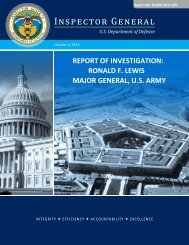Command Red Team
2gWzzvB
2gWzzvB
Create successful ePaper yourself
Turn your PDF publications into a flip-book with our unique Google optimized e-Paper software.
<strong>Red</strong> <strong>Team</strong> Activities<br />
3. Critical Review<br />
a. <strong>Red</strong> teams can also conduct independent critical reviews of concepts,<br />
organizational designs, wargames and exercises, experiments, and processes to identify<br />
potential weaknesses and vulnerabilities. Overall, critical reviews increase operational<br />
effectiveness and reduce risk by stimulating critical and creative thought, by expanding<br />
the scope of analysis to consider a wider range of perspectives and potential solutions,<br />
and by uncovering flaws and weaknesses before decisions are finalized and missions are<br />
executed.<br />
b. A critical review may focus on the information that was used to support a<br />
decision (the “input”), the thinking used to understand and act on the information (the<br />
“process”), or the resulting decision or COA (the “output”). Some critical reviews may<br />
focus on helping the staff understand a problem, while others may focus on helping the<br />
staff see more potential solutions to a problem. If successful, a critical review can<br />
improve understanding of complex issues where information is incomplete, ambiguous,<br />
or deliberately distorted. An effective review may prompt the staff to consider new<br />
COAs, plan against new contingencies, increase collection and analysis in new directions,<br />
or take some other affirmative action to improve understanding, sharpen thinking, and<br />
reduce risk. In some cases, a critical review may affirm the staff’s thinking and increase<br />
confidence in its original assessments and decisions.<br />
c. Critical reviews draw on all the red team’s core competencies, especially critical<br />
thinking, alternative analysis, and situational dynamics. Critical reviews place the red<br />
team in the role of devil’s advocate and staff contrarian, constructively helping the staff<br />
see more perspectives, consider more interpretations, visualize more factors, and explore<br />
more alternatives, while simultaneously avoiding analytical errors and minimizing<br />
institutional constraints. A red team drawn from diverse backgrounds is better prepared<br />
to conduct critical reviews.<br />
d. When conducting a critical review, the red team must first understand the<br />
customer’s objectives. For example, a commander may request a review of a plan or the<br />
plan’s supporting intelligence estimates in preparation for a plan revision. The<br />
commander should specify whether they wish to review the finished red team product<br />
personally, or whether they want it presented directly to a planning team. Any special<br />
instructions, such as a desired focus on the plan’s information operations (IO) aspects,<br />
asymmetric aspects of the adversary’s doctrine, or emerging technological advances, or<br />
directions to assume that certain regional states will adopt particular stances, should be<br />
clarified and understood by the red team. Finally, the format of the final product (e.g.,<br />
briefing, staff paper, or participation on a planning team) should be specified.<br />
e. Subject to the commander’s direction, the red team may initiate a critical review<br />
of existing assessments, warning problems, contingency plans, operational concepts, staff<br />
proposals, technological initiatives, exercise or experiment design, or any other issue that<br />
may benefit from a critical, independent second look. Due to the individual and<br />
institutional factors discussed in Chapter III, “<strong>Command</strong> <strong>Red</strong> <strong>Team</strong> Challenges,” the<br />
IV-5



